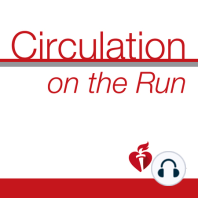18 min listen
Circulation July 28, 2020 Issue
ratings:
Length:
22 minutes
Released:
Jul 27, 2020
Format:
Podcast episode
Description
Dr Carolyn Lam: Welcome to Circulation on the Run, your weekly podcast summary and backstage pass to the journal and its editors. I'm Dr Carolyn Lam, associate editor from the National Heart Center and Duke National University of Singapore. Dr Greg Hundley: And I'm Dr Greg Hundley, associate editor, Director of the Pauley Heart Center from VCU Health in Richmond, Virginia. Dr Carolyn Lam: Our feature paper today discusses trans-ethnic genome-wide association studies and the insights in the genetic architecture and heritability of long QT syndrome, a massive study that we will be digging into, but only after we talk a little bit about the other papers in this week's issue. And I'm going to start, Greg. Are you ready with your coffee? Dr Greg Hundley: I am. Dr Carolyn Lam: The first original paper really represents seminal work, showing that the endothelium can directly regulate obesity and insulin resistance. Now, as obesity develops, there is a decline in adipose tissue vascularity, which seems counterintuitive, and an increase in fibrosis. So authors, led by Dr Chen from the Irell and Manella Graduate School of Biological Sciences in the City of Hope, speculated that the reduction in vascularity in this adipose tissue might have an adverse effect on adipose tissue function. Now, these authors previously identified Argonaute-1, or AG01, a key component of microRNA-induced silencing complex, as a crucial regulator in hypoxia-induced angiogenesis. So in the current study, they aim to determine the AG01-mediated endothelial cell transcriptome, the functional importance of AG01-regulated endothelial function in vivo, and the relevance to adipose tissue function and obesity. A new mouse model with genetic deletion of AG01 in the endothelium was useful to investigate the importance of endothelial regulation of adipose tissue function. The findings were that in mice fed high fat, high sucrose diet, the suppression of endothelial AG01 promoted adipose tissue browning, and led to an anti-obesity phenotype. Endothelial cell AG01 thrombospondin-1 pathway was induced in the endothelium from human donors with insulin resistance. In total, this study suggests a novel mechanism, by which endothelial cells through AG01 thrombospondin-1 pathway controls vascularization and function of adipose tissues, insulin sensitivity, and whole-body metabolic state. Dr Greg Hundley: Interesting, Carolyn. So tell me about this clinically. Where do we take this from here? Dr Carolyn Lam: I thought you would ask. So endothelial dysfunction, per se, can cause metabolic dysregulation, rendering targeting dysfunctional endothelium, a potential therapeutic strategy to counteract obesity, and metabolic disorders. So this study really opens a door to that. Dr Greg Hundley: Very nice. Well, I've got another basic science paper, and it evaluates single-cell RNA sequencing to dissect the immunological network of autoimmune myocarditis. And it comes from Dr Jiangping Song from the State Key Laboratory of Cardiovascular Disease of Fuwai Hospital, and the National Center for Cardiovascular Disease, Chinese Academy of Medical Sciences, and Peking Union Medical College. So Carolyn, the study aimed to investigate the immunological network during the transition from myocarditis to cardiomyopathy, and to identify the genes contributing to the inflammatory response to myocarditis. So mice were treated with myosin heavy chain alpha-peptides to generate an experimental autoimmune myocarditis model. The investigators performed single-cell RNA sequencing analysis of CD45 plus cells extracted from mouse hearts during different experimental autoimmune myocarditis phases, including normal control, acute inflammation, subacute inflammation, and then in the myopathy phase. Also, human heart tissues were collected from surgically removed hearts of patients who had undergone heart transplantation. Dr Carolyn Lam: So what did they find, Greg? Dr Greg Hundley: Well, Carolyn, a comparison o
Released:
Jul 27, 2020
Format:
Podcast episode
Titles in the series (100)
Circulation January 23, 2018 Issue by Circulation on the Run
